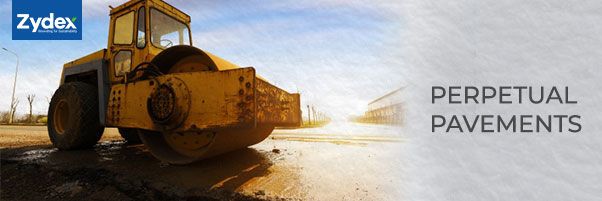Perpetual Pavements are pavements designed and constructed to last > 50 years, with maintenance restricted to the wearing course alone. Perpetual pavements have high structural strength and offer long term resistance to two most devastating distresses i.e. structural rutting and fatigue cracking, keeping the compressive and tensile strains below the failure limits.
Traditionally, highways are designed for a 20 year design life, whereas perpetual pavements are expected to perform for 50 years or more. These pavements are designed with a strong, flexible bottom layer that resists cracking under heavy traffic loads and cyclic weather variations. Several practices such as soil stabilisation using materials like cement, lime, bitumen emulsion and installation of geogrids & geotextiles are adopted to ensure a strong and dimensionally stable base. These practices help improve the engineering properties of the bottom layers. New and emerging technologies such as organosilanes & polymers, offers further improvement in terms of moisture resistance, higher strength and flexible nano bonding. This increases the durability (lifespan) of the pavement layers significantly. Use of emulsion additives also help in effective bonding of the different layers for uniform load/stress transfer.
The bituminous layers of the pavements offer flexibility and resistance to deformations. However, factors such as material variability and operational inefficiencies causes serious problems which lead to premature failures. For example, improper coating of the bitumen on aggregate surface results in water ingress and delamination of the layers, thereby reducing its ability to withstand heavy loads. Therefore, bitumen additives are used at times, to improve the properties of the bituminous mixes. Bitumen additives such as anti stripping agents improve the cohesion between aggregate & bitumen and ensures a tightly bonded structure, thereby facilitating better stress transfer under heavy loads. This eventually translates to longer pavement life. Innovative practices such as the use of Warm Mix Asphalt provides additional environmental benefits by facilitating reduced odor & emissions, lesser fuel consumption and paving friendliness.
The benefit of restricting distress formation to the top layer, is to ensure that when distresses exceed tolerance limits, the distressed top layer can be removed and resurfaced with an asphalt overlay. Cost effective solutions such as microsurfacing or slurry seal can be adopted to ensure a smooth ride quality, thereby reducing the maintenance costs and time.
Perpetual pavements, therefore, offer a durable, long-lasting road, with cost-effective maintenance that restricts traffic disruption thereby saving time for road users and the maintenance crew. Reduced maintenance also conserve the use of the scarce natural resources such as aggregates and bitumen, to provide significant environmental benefits as well as cost savings.
The future lies in high-strength pavements that are faster to construct using limited natural resources, and when constructed for perpetuity, will never need to be reconstructed.







